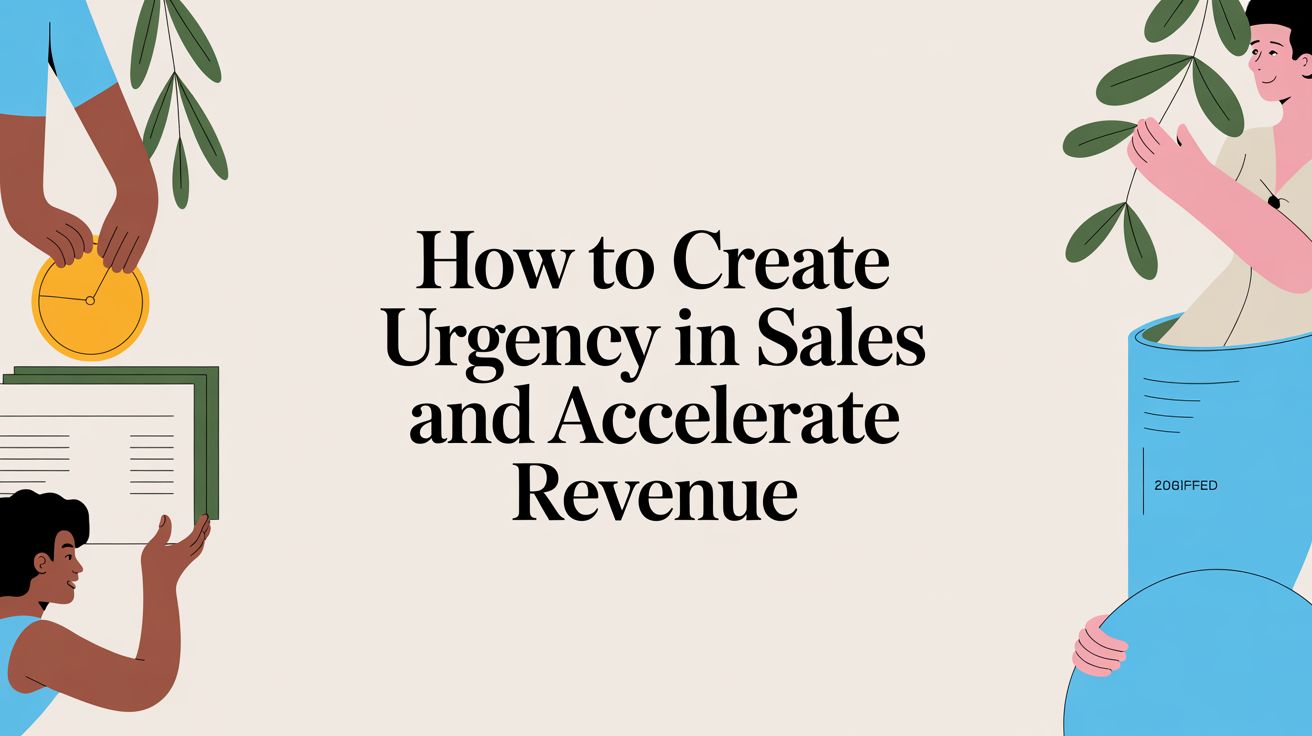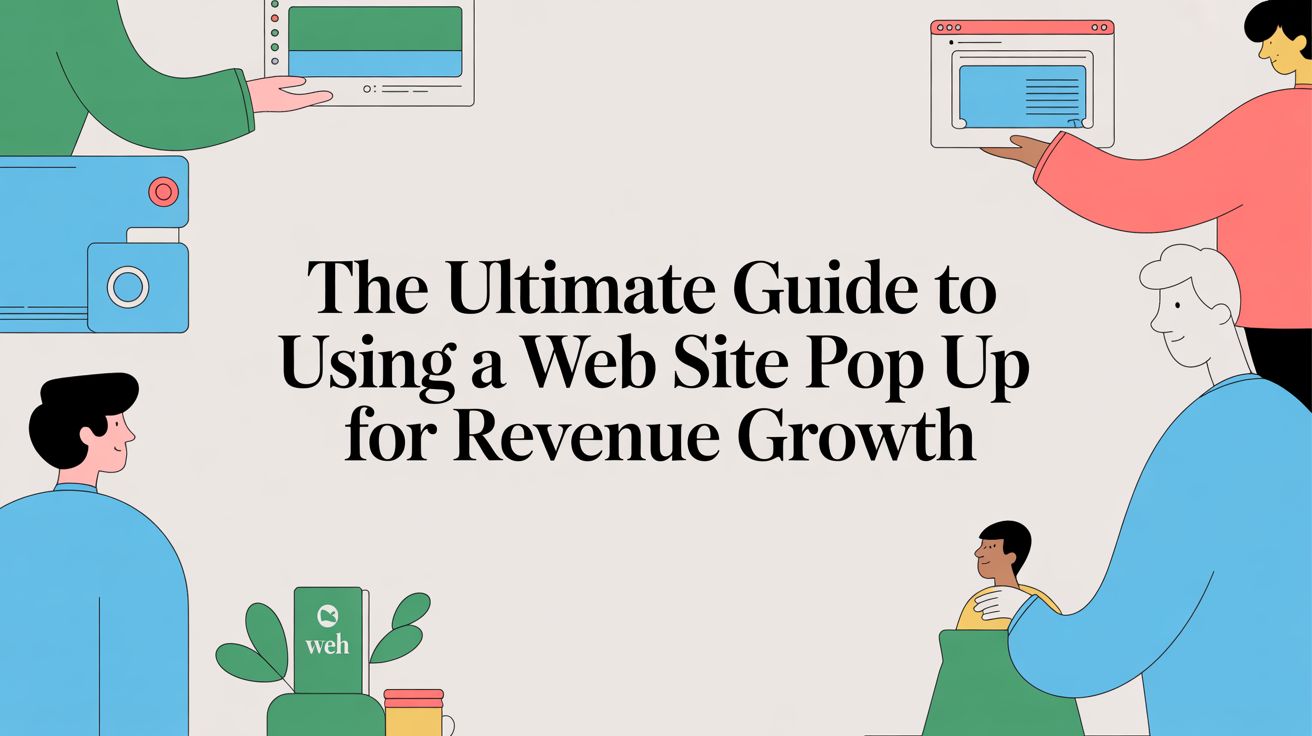
Your Expert Shopify Black Friday Guide to Maximizing Revenue
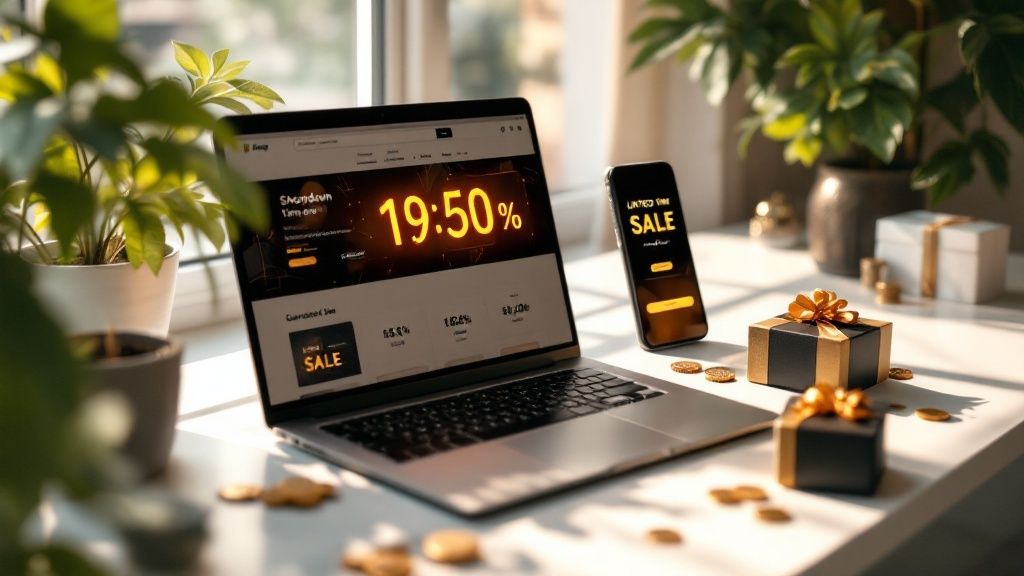
To truly maximize your Shopify Black Friday performance, you must move beyond simple discounts. Lasting success stems from understanding the behavioral economics that trigger urgency and drive consumers to buy now. This scientific approach is how you convert a chaotic sales event into a record-breaking revenue driver for your brand.
The Psychology Behind Record-Breaking Black Friday Sales
The Black Friday phenomenon is more than just good deals; it's a massive, real-world experiment in consumer psychology. For Shopify merchants, mastering these principles is the difference between a minor sales bump and a quarter that shatters revenue goals.
The average ecommerce conversion rate hovers around 2.5%. However, brands that strategically leverage behavioral triggers can achieve significantly higher performance.
This isn't about manipulation. It's about understanding the science of what motivates your customers and transforming a simple transaction into an engaging, memorable event. This is the core of Quikly's approach to urgency marketing—a science designed to drive ROI.
The Science of Urgency and Scarcity
The two most powerful forces in your Black Friday toolkit are scarcity and urgency, both deeply rooted in behavioral psychology. When consumers perceive something as limited, its value immediately increases in their minds—a principle known as the scarcity heuristic. This directly taps into the fear of missing out (FOMO), a powerful cognitive bias that compels people to make a decision.
A basic countdown timer attempts to create urgency, but savvy consumers have developed "banner blindness" and often ignore it. It lacks genuine stakes.
Advanced urgency marketing, in contrast, creates real consequences. It connects the time limit to something tangible, like a limited-quantity product drop or a tiered offer where the fastest shoppers receive the best rewards. This establishes believable scarcity that helps combat the staggering 70% average cart abandonment rate and motivates customers to complete their purchase.
Building Trust Through Social Proof
Another critical psychological component is social proof. When shoppers are uncertain, they instinctively look to the actions of others to validate their decisions. That's why leveraging social proof on your website is non-negotiable for building trust and amplifying urgency.
You can implement this with simple yet powerful tactics:
- Showcasing real-time notifications of who is buying what.
- Displaying genuine customer reviews and testimonials.
- Using "Bestseller" badges to highlight products with high social validation.
These tactics transform shopping from a solitary activity into a shared, communal experience. They provide psychological reassurance that buying from you is a good decision because many others have already made the same choice.
"The true power of urgency marketing lies in its ability to align with natural human decision-making processes. It’s not about forcing a sale; it’s about creating an environment where the customer feels confident and excited to act."
The historical data from past Shopify Black Friday events proves the magnitude of this opportunity.
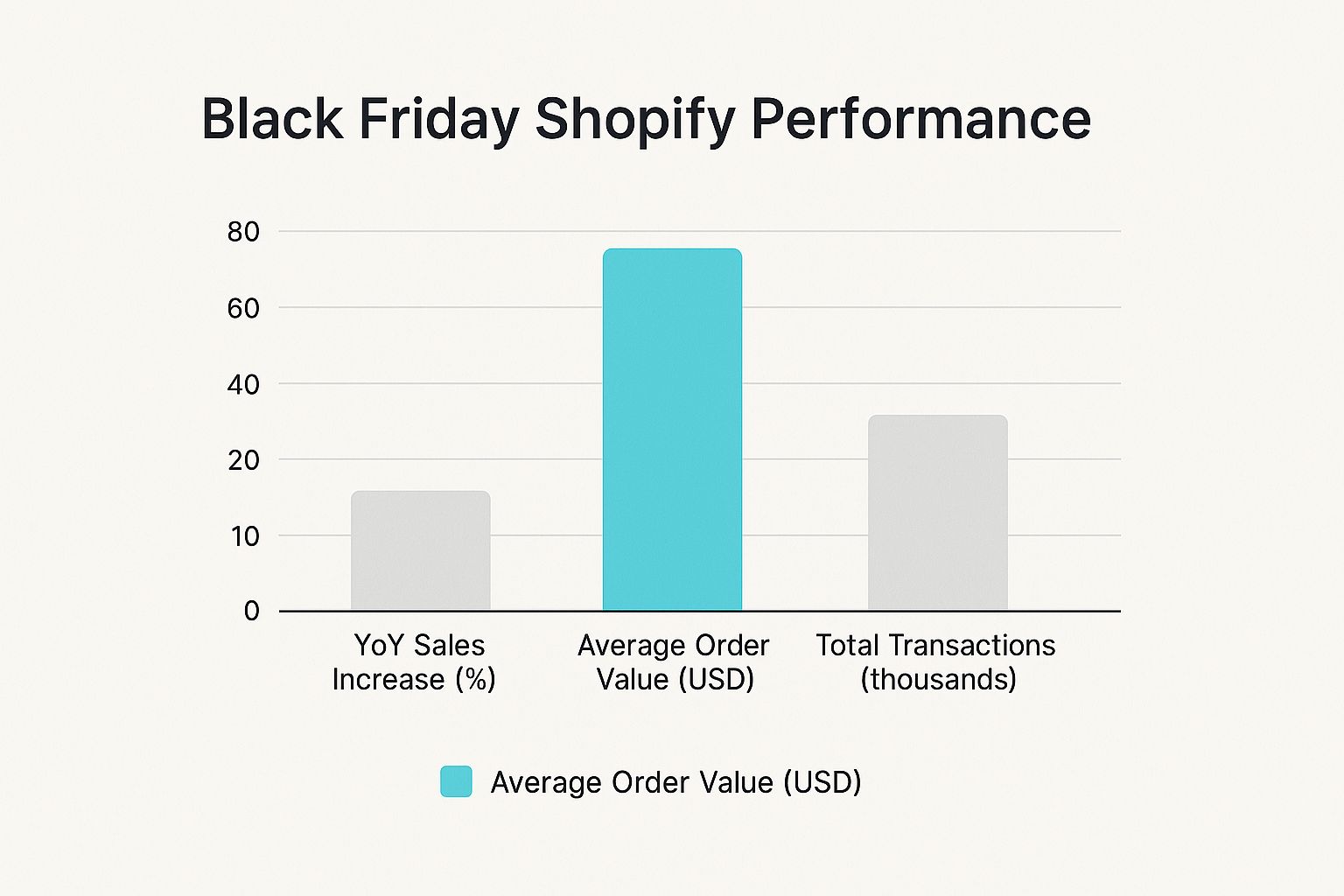
The consistent growth in sales and transaction volume is undeniable. This underscores why a sophisticated, psychology-driven strategy is essential to claim your share of the revenue.
Standard BFCM Tactics vs Advanced Urgency Marketing
Not all urgency tactics are created equal. While basic approaches might yield a small lift, advanced strategies rooted in psychology deliver exponentially better business outcomes. The table below contrasts the difference.
| Business Metric | Standard Tactic (e.g., Simple Countdown Timer) | Advanced Strategy (e.g., Gamified Scarcity) | Expected Business Impact |
|---|---|---|---|
| Conversion Rate | A generic "Sale Ends Soon" timer on the homepage. | A ranked offer where the first 100 buyers get 40% off, the next 200 get 30%, etc. | Significant lift in conversion as FOMO drives immediate action to secure the best deal. |
| Average Order Value | A simple site-wide discount (e.g., 20% off everything). | Tiered rewards that unlock free shipping or a gift-with-purchase at higher spending thresholds. | Encourages customers to add more to their cart to reach the next reward level. |
| Customer Engagement | A basic pop-up announcing the sale. | An interactive "drop" event where customers must sign up to be notified the second the deal goes live. | Builds an engaged list and creates a "can't miss" moment, driving a surge of traffic and sales. |
| Profit Margin | Deep, across-the-board discounts that erode margins. | Strategic, limited-quantity offers on specific high-margin products. | Protects profitability by focusing urgency on products that can sustain a discount. |
The shift from generic tactics to strategic, psychology-based campaigns is what separates an average BFCM from a legendary one.
Understanding how the psychology of Black Friday can inspire a new approach is the first step. By moving beyond generic timers and pop-ups, you can create memorable "Moments" that don't just convert browsers into buyers, but also turn seasonal shoppers into loyal, year-round customers.
Building Anticipation Before Black Friday Hits
A truly massive Shopify Black Friday campaign doesn’t just happen when the clock strikes midnight. The brands that generate the most revenue have been priming their audience for weeks. They turn a simple sale into an event people are genuinely excited about.
This groundwork is about tapping into powerful psychological triggers. The goal is to shift your customer’s mindset from passive awareness to active anticipation. You're building what psychologists call anticipatory pleasure—where looking forward to an event feels almost as rewarding as the event itself. Master this, and your email and SMS lists will be ready to purchase the moment you go live.
Weave a Compelling Narrative with Your Lists
Your email and SMS subscribers are your most valuable asset. Unlike cold traffic from an ad, these individuals have explicitly opted-in to hear from you. The weeks leading up to Black Friday are your opportunity to tell a story, not just announce a sale.
Integrate your Shopify store with a platform like Klaviyo or your preferred SMS tool to create a multi-channel narrative. Avoid the single "Our sale is coming" email. Instead, think in strategic sequences.
- Four Weeks Out: Send the first hint. Announce that something "big" is in the works for Black Friday, but maintain an air of mystery. Let them know it's going to be your most significant event of the year.
- Two Weeks Out: Begin teasing the types of offers. Mention a "limited-edition drop" or "exclusive bundles" created just for the occasion.
- One Week Out: Ramp up the anticipation. Increase email and text frequency and start revealing more concrete details to drive sign-ups for an early access list.
This deliberate, slow-burn approach is far more effective than a last-minute blast. It makes your subscribers feel like insiders, creating a sense of community that translates directly into sales.
Segment Audiences for VIP Early Access
Few marketing principles are as effective as exclusivity. Making your best customers feel special is a direct line to their loyalty—and their revenue contribution. Before the main event, segment a VIP group from your audience that gets to shop first.
Creating a VIP segment isn't just a marketing tactic; it's a behavioral trigger. By offering exclusive early access, you activate the principle of reciprocity—customers feel valued and are psychologically more inclined to make a purchase when the sale opens up to them.
Dive into your Shopify and email platform data to build this list. Key segments include:
- Past BFCM Shoppers: Anyone who purchased during last year's sale is a prime candidate.
- High LTV Customers: These are your most valuable customers with the highest lifetime value.
- Recent Purchasers: Customers who've bought in the last 60-90 days are still highly engaged.
Send this group a dedicated campaign announcing their 24-hour head start on all deals. This not only rewards your best customers but also creates powerful FOMO for everyone else, encouraging them to engage more to make the VIP list next time.
Strategically Tease Limited-Edition Drops
A generic "up to 50% off" sale is background noise. But a "Limited Drop of 100 Units"? That’s an event.
Use the weeks before Black Friday to build hype around specific, scarce products. Share sneak peeks of these exclusive items on Instagram, TikTok, and in your emails. Use language that reinforces tangible scarcity: "Only 250 will ever be made," or "Once it's gone, it's gone forever."
This sophisticated strategy shifts the focus from a race-to-the-bottom discount to a must-have product, which is crucial for protecting your brand's perceived value and your profit margins.
The best part? This approach creates a "halo effect" of urgency across your entire store. When shoppers flood your site for the limited drop, they’re already primed with a scarcity mindset, making them more likely to purchase other items before they, too, potentially sell out.
Executing Dynamic Urgency Campaigns That Convert
To truly dominate Black Friday on your Shopify store, you must evolve past the generic, store-wide countdown timer. Modern shoppers see right through that tactic. The goal isn't just to have another sale; it's to create an active, engaging event engineered for high ROI.
This means executing dynamic campaigns rooted in behavioral psychology. We’re talking about campaigns that command attention and drive immediate action. Forget the interruptive pop-up that only captures an email. We're architecting revenue-generating "Moments" that leverage real, provable scarcity to reward customers who act fast. This is the difference between hoping for a sales spike and actively engineering one.
Launching Limited-Quantity Product Drops
One of the most effective ways to apply urgency is with a limited-quantity product drop. Instead of a blanket discount that can devalue your brand, you build concentrated hype around a specific item. This strategy taps directly into the psychological principle of scarcity, where an item's perceived value skyrockets simply because it’s difficult to acquire.
Here’s an actionable plan for maximum impact:
- Pick the Right Product: Choose a high-margin hero product, a unique colorway of a bestseller, or a specially curated bundle. The key is offering something exclusive that customers can't get any other time.
- Make the Scarcity Real: Be transparent about the exact quantity available. For example, "Only 150 units available." This feels genuine and believable, unlike a vague "limited time offer."
- Build the Hype: Use your email, SMS, and social media channels in the weeks leading up to Black Friday to tease the drop. Announce the exact launch time to prime your audience to act the second it goes live.
This approach drives a massive spike in traffic and sales while also helping you strategically manage inventory. A drop can clear overstock of a particular product without resorting to a profit-killing, store-wide clearance.
Gamifying the Shopping Experience with Ranked Offers
Another sophisticated strategy is to gamify the buying process with ranked offers. This rewards the fastest customers with the best deals, creating a competitive and exciting shopping experience. It's a powerful way to use urgency to overcome purchase hesitation.
For instance, you could structure a campaign like this:
- Tier 1: The first 100 customers get 40% off.
- Tier 2: The next 250 customers get 30% off.
- Tier 3: Everyone else gets 20% off until the campaign ends.
This dynamic structure transforms a passive discount into an interactive event. It provides a powerful incentive to buy now instead of later, which is crucial for converting browsers who might otherwise abandon their carts. For a deeper dive, explore these 10 powerful urgency marketing tactics you can adapt for your BFCM campaigns.
The peak sales moment during the last Black Friday occurred at 12:01 p.m. EST, when sales surged to $4.6 million per minute. This illustrates the incredible power of concentrated, event-based shopping moments.
This data point proves that customers are ready to act when the moment feels important. During the last Black Friday-Cyber Monday weekend, Shopify merchants collectively achieved a record-breaking $11.5 billion in sales, a 24% increase from the previous year. It shows just how massive the opportunity is for those who get it right.
The Quikly Advantage Over Basic Apps
This is where the science of urgency marketing diverges from basic Shopify apps. A simple timer or generic pop-up is a blunt instrument, applying the same pressure to every visitor, regardless of their intent. These tools are easily ignored and are often focused on low-value actions like email capture.
Dynamic campaigns powered by Quikly, in contrast, are designed for one singular purpose: revenue generation.
| Tactic Comparison | Basic Pop-Up App | Dynamic Urgency Campaign (Quikly) |
|---|---|---|
| Primary Goal | Email capture | Direct revenue & ROI |
| Psychological Trigger | Interruptive annoyance | Scarcity, FOMO, competition |
| Customer Experience | Passive, often ignored | Active, engaging, gamified |
| Business Impact | Grows email list | Increases AOV, manages inventory |
By creating these high-stakes, time-sensitive events, you’re not just hoping for conversions; you’re creating the perfect conditions for them to happen. A successful Black Friday comes down to improving ecommerce conversion rates and ensuring your efforts translate into profitable sales.
Protecting Profit Margins During Peak Sales Season
The massive sales volume of a Shopify Black Friday can be exhilarating, but it often comes at a steep cost: aggressive, site-wide discounts that crush your profit margins. Brands feel pressured to compete by slashing prices, turning a revenue windfall into a logistical headache with minimal returns.
A smarter approach involves moving beyond the race to the bottom and using the science of urgency to drive sales while protecting your bottom line.
This isn't just about making sales; it's about making profitable sales. Instead of a generic 30% off banner that devalues your entire catalog, you can build targeted campaigns that feel like exclusive events. This drives a much higher ROI and preserves your brand's integrity.
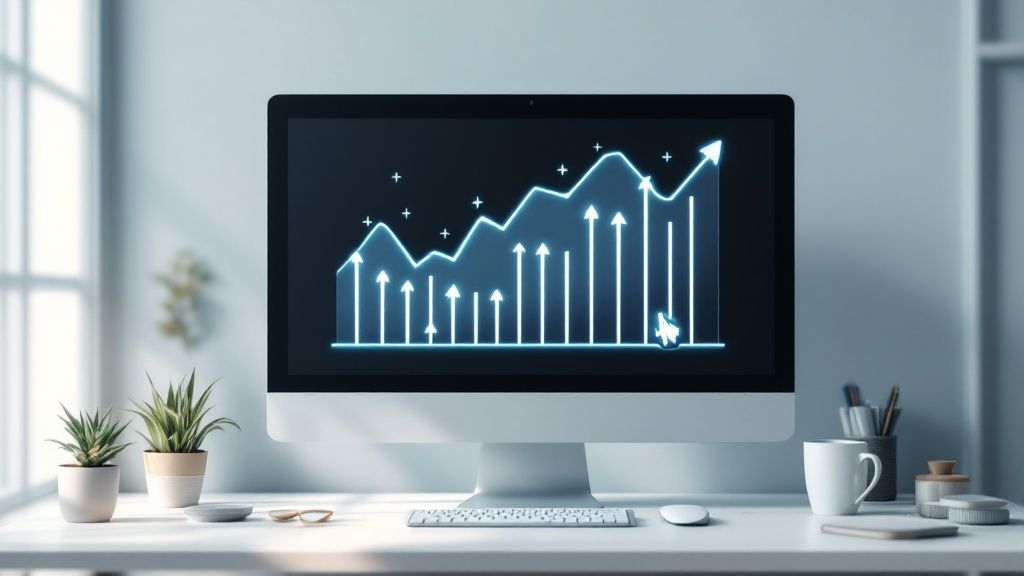
Strategically Clear Overstock with Limited Drops
Every Shopify merchant has overstock—products sitting in a warehouse, tying up capital. While a blanket discount might move them, it also trains customers to wait for sales on your bestsellers.
A far more strategic solution is a limited-quantity drop focused specifically on that overstock inventory.
By framing the sale around a finite number of items (e.g., "Only 75 available at this price!"), you trigger the psychological principle of scarcity. Suddenly, those slow-moving products become a can't-miss opportunity. Shoppers aren't just getting a deal; they're participating in an exclusive offer before it's gone. It’s an incredibly effective way to manage inventory, clear old stock, and generate excitement simultaneously.
This strategy is a world away from basic pop-up apps that just try to grab an email. A limited drop is a revenue-generation tool built for immediate ROI and smart inventory control—a critical function for enterprise-level Shopify Plus merchants juggling complex stock levels.
It’s a surgical strike, not a carpet bomb. You avoid sacrificing margins on your best-selling products just to move less popular inventory.
Incentivize Higher Spending with Tiered Offers
Another powerful tactic for defending profitability is the tiered offer. Instead of giving everyone the same flat discount, you reward customers for spending more. This is a direct lever for increasing your average order value (AOV)—a metric critical for sustainable growth, especially when customer acquisition costs are high.
A tiered structure might look like this:
- Spend $75, Get 15% Off: Rewards a standard purchase.
- Spend $125, Get 25% Off: Nudges shoppers to add one more item to their cart.
- Spend $200, Get a Free Gift + 25% Off: Creates a powerful incentive to maximize their order.
This model effectively gamifies the shopping experience. Customers see a clear path to a better deal, which often motivates them to push their cart value over the next threshold. It’s a win-win: the customer feels they’ve unlocked great value, and you achieve a larger, more profitable order.
The opportunity is massive. During a recent BFCM weekend, Shopify merchants saw $9.3 billion in sales from over 61 million consumers, with an average cart size of $108. By using tiered offers, you can actively work to push that AOV even higher for your store. You can read more about Shopify's record-breaking sales weekend.
Turning Seasonal Shoppers into Loyal Customers
Once the Cyber Monday dust settles, the real work begins. The large influx of new buyers from your Shopify Black Friday sale represents a massive opportunity, but only if you have a strategic plan to retain them.
Your objective now is to convert those one-time deal-seekers into genuine, year-round brand advocates. This requires a smart post-purchase strategy that shifts the conversation from price to long-term value.
Segment Your New Customer Cohort
First, you must separate this new group from your existing customer base. Not all Black Friday shoppers are the same, and they require a different communication strategy.
Within your Shopify admin and integrated tools like Klaviyo, create a specific segment for "BFCM 2024 Purchasers." This simple action is your foundation, allowing you to send hyper-relevant follow-ups that acknowledge the context of their first purchase.
Craft a Targeted Post-Purchase Flow
With your new segment defined, build a dedicated post-purchase automation. This is not a standard “thanks for your order” email. It is a welcome sequence designed to build a genuine connection.
Here is a simple but effective flow:
- Email 1 (Immediately after purchase): Acknowledge their BFCM purchase. A simple, "Thanks for shopping with us during the craziest weekend of the year!" shows you understand who they are and why they bought.
- Email 2 (3-5 days later): Tell your brand story. Share your mission, what makes your products unique, or a behind-the-scenes look at your team. This begins building a relationship beyond the discount.
- Email 3 (7-10 days later): Ask for a review or user-generated content (UGC). You can incentivize this with a small offer, like 10% off their next order, to encourage engagement and build social proof.
- SMS Nurturing: Don't neglect text messaging. A quick SMS a week after their order arrives asking how they're enjoying the product feels personal and opens a direct line for valuable feedback.
A critical mistake merchants make is treating Black Friday buyers like any other customer. By failing to acknowledge the specific context of their purchase—a high-stakes, discount-driven event—brands miss the opportunity to reframe the customer relationship around value, not just price.
Leverage Campaign Data for Future Personalization
The behavioral data you collected during your Shopify Black Friday event is a goldmine. Analyze what these new customers purchased. Did they respond to limited-edition drops? Were they motivated by tiered offers? This data reveals their core motivations.
Use this intelligence to personalize future marketing. If a customer bought a specific bundle, you know exactly what complementary products to recommend. If they responded to a scarcity-driven campaign, they are the perfect audience for your next limited release.
The sheer volume of shoppers provides a powerful dataset. Just last Black Friday weekend, Shopify merchants generated $11.5 billion in sales from over 76 million customers worldwide. By analyzing the patterns within your segment of that activity, you can uncover trends to inform your marketing for the entire year. You can learn more about Shopify's impressive BFCM statistics and what they reveal about modern shopping habits.
Driving the Crucial Second Purchase
Ultimately, your goal is to secure that second sale. Once a customer makes a second purchase, their likelihood of becoming a long-term loyalist increases dramatically. This is where a formal loyalty program is most effective.
Send a special invitation to your new BFCM customer segment, inviting them to join your rewards program. Frame it as an exclusive perk. Offering bonus points for signing up is often the perfect incentive to bring them back for another purchase outside of a major sales event. If you're looking for more ideas, check out this all-encompassing guide to loyalty programs.
By implementing these strategies, you transform a short-term sales win into a long-term asset, building a loyal customer base that drives revenue long after the holiday season.
Your Shopify Black Friday Questions Answered
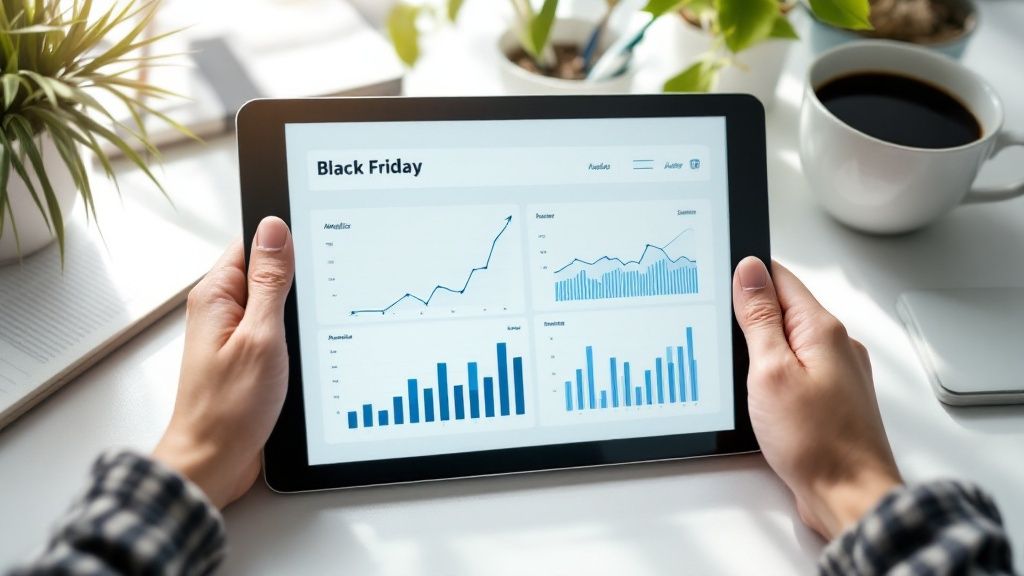
Executing a successful Black Friday campaign on Shopify is part art, part science. It requires strategic planning, a deep understanding of consumer psychology, and flawless execution. To help you refine your approach, we’ve answered the most common questions from merchants preparing for the biggest sales day of the year.
How Far in Advance Should I Plan My Campaign?
Ideally, you should begin planning 8-12 weeks in advance. This timeframe allows for strategic work, not just a last-minute scramble.
Starting early provides sufficient time to properly segment audiences, build a compelling narrative for your anticipation campaigns, and configure and test any new marketing tools. This is how you prime your audience to be ready to buy the second your sale goes live. It transforms a day that feels chaotic for most into a controlled, high-revenue event for you.
Are Deep Discounts the Only Way to Succeed?
Absolutely not. In fact, offering deep, site-wide discounts is often a recipe for disaster—it decimates profit margins and can devalue your brand long-term.
A much smarter strategy uses psychological triggers to create value beyond the price tag. A small discount on a limited-quantity product drop can generate significantly more excitement and urgency than a generic, store-wide 50% off sale. The key is to shift the customer’s focus from how much they’re saving to how exclusive the offer is. Product bundles, VIP early access, and unique gifts-with-purchase are all powerful ways to protect your profitability.
"True success on Black Friday isn't measured by the depth of your discounts, but by the strength of your profit margins. Sophisticated urgency marketing allows you to drive record sales without sacrificing the financial health of your business."
How Is Advanced Urgency Different From a Simple Timer?
A simple countdown timer is a passive tool that modern shoppers have learned to ignore. It lacks the context or genuine stakes required to inspire immediate action.
Advanced urgency marketing, on the other hand, is dynamic, interactive, and rooted in real behavioral science. It uses tangible factors to create scarcity that feels believable and drives immediate decisions. Examples include:
- Real-time inventory scarcity showing exactly how many units are left.
- Gamified ranked offers where the fastest shoppers get the best deals.
- Personalized, time-sensitive rewards that feel uniquely tailored to the customer.
This approach is far more effective because it actively engages customers in an experience, whereas a basic timer merely broadcasts a deadline.
How Can I Measure the ROI of My Urgency Campaigns?
To truly measure ROI, you must look beyond a simple conversion rate. Track a combination of metrics that paints a full picture of the business impact.
Focus on the lift in Average Order Value (AOV) from tiered offers and the sell-through rate of products featured in limited drops. Monitor the decrease in your cart abandonment rate during the campaign. Most importantly, compare the increase in your overall revenue and—critically—your profit margin against previous Black Friday performance. The best platforms provide detailed analytics that attribute sales directly to specific campaigns, giving you a clear, undeniable picture of your return.
Ready to move beyond basic timers and build urgency that actually drives revenue? Quikly provides the tools to create sophisticated, psychology-driven campaigns that turn browsers into buyers and protect your bottom line.
See how Quikly can transform your Shopify Black Friday sales.

The Quikly Content Team brings together urgency marketing experts, consumer psychologists, and data analysts who've helped power promotional campaigns since 2012. Drawing from our platform's 70M+ consumer interactions and thousands of successful campaigns, we share evidence-based insights that help brands create promotions that convert.
